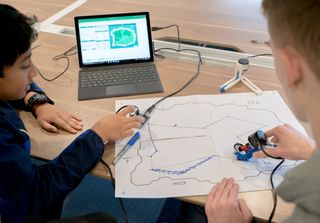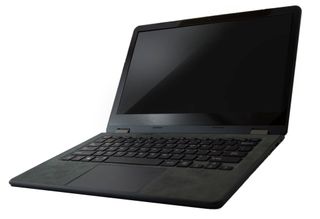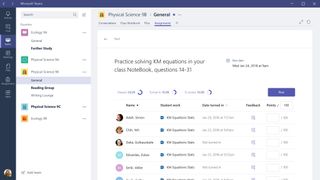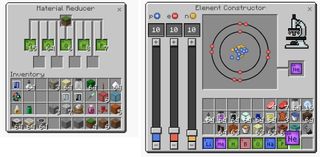Microsoft doubles down on education market with new partnerships and devices
A cadre of new announcements looks to keep Microsoft's education momentum going around the world.

Microsoft is finally seeing substantial growth in the education sector with growth last quarter.
According to Futuresource{.nofollow}, the worldwide education market grew 15 percent year-over-year. Windows sales grew 4.3 percent in the US on devices under $300 USD and 8.2 percent on devices over $300 USD.
That trend should continue, because today Redmond is announcing multiple new partnerships in education and science, technology, engineering and mathematics (STEM) fields.
Also, Minecraft for Education is getting a chemistry add-on; Lenovo and JP are announcing new, low-cost laptops for students; and augmented reality (AR) and HoloLens will get some new apps for students.
New, affordable laptops for students

Windows 10 places a heavy emphasis on inking, voice, and 2-in-1 laptop designs. Lenovo and JP (who makes devices for outside the U.S.) are announcing four new laptops that will offer these technologies to students at a price school districts can afford:
Lenovo education laptops:
- The Lenovo 100e, a brand-new Intel Celeron Apollo Lake-powered PC, starting at just USD $189.
- The Lenovo 300e, an affordable 2-in-1 convertible PC with pen support, starting at USD $279.
Two new devices from JP, who focuses on emerging markets:
- The Classmate Leap T303 laptop with Windows Hello, starting at USD $199.
- The Trigono V401 2-in-1 with pen and touch, starting at USD $299.
Those new devices join the ones announced last summer, including the HP ProBook x360 11 EE, which according to Microsoft, "continues to be one of our best-selling 2-in-1 devices in education at just USD $299". There's also the recently released HP Stream 11 Pro G4 EE PC starting at USD $225. Microsoft notes "they are all spill resistant and ruggedized to avoid accidental breakage, have long battery life to avoid charging wires all over the classroom, and have faster connectivity."
Teams, OneNote, Microsoft Learning Tools and more

Besides hardware, Microsoft is announcing new updates and partnerships for much of its software that does double duty in schools. Things like "Immersive Reader" (which is found in Microsoft Edge in the latest Windows Insider builds) is coming to Microsoft Word, Outlook, and OneNote for Mac, iPad, and desktop.
Microsoft detailed many of the new changes including a significant partnership with SIMS Capita in the U.K. and PowerSchool in the U.S. – two of the most popular School Information Systems around.
Get the Windows Central Newsletter
All the latest news, reviews, and guides for Windows and Xbox diehards.
From Microsoft:
- Microsoft Learning Tools improves reading, writing, and comprehension for all students, especially the one in five students who have a learning difference. Starting in February, we will introduce dictation in Office 365 to help students write more efficiently by using their voice. Immersive Reader functionality will also expand to Word for Mac, iPhone, Outlook Desktop, OneNote iPad, and OneNote Mac with support for many new languages.
- OneNote Class Notebook, which has added more than 15 million new student notebooks since the beginning of this school year, will now include assignment and grade integration with the most widely used School Information Systems in the UK (SIMS Capita) and U.S. (PowerSchool).To further simplify classroom workflows, we are delivering on the number one request from teachers for Class Notebooks, enabling them to lock pages as read-only after giving feedback. In OneNote, we are also enabling Desmos interactive math calculators, a set of popular applications for STEM teachers.

- Teams, a digital hub for the classroom, is now accessible on iOS and Android so teachers and students can now keep track of their assignments and classroom conversations on their phones or tablets. To enable language learners to engage in classroom conversations, our newest updates will also make it easy to translate any conversation or chat into another language.
- PowerPoint will now allow teachers to record their lessons including slides, interactive ink, video, and narrations and publish to their Stream channel in Teams classrooms. This way, students can view from anywhere in advance of class, so class time can be used for conversation. Stream will also add automatic captioning to the videos to make them accessible to all learners.
The PowerSchool announcement in the U.S., in particular, should be essential for Microsoft. PowerSchool focuses on K-12, and with Microsoft partnering with the group it should get Windows into the hands of more students.
STEM, Mixed Reality, LEGO, and Minecraft are the future

Science, technology, and math all go well with Windows Mixed Reality and HoloLens, which is why Microsoft is working hard to get the gear into classrooms.
MakeCode is bringing its new Cue Education app first to Windows starting today. It joins MakeCode for Minecraft and MakeCode for micro:bit, also on Windows 10.

Perhaps in one of the most obvious applications of the popular Minecraft game, which turned into a tool for learning last summer, is the new Chemistry Update due this spring. Players already spend time crafting recipes to make new items in the game, so extending that model to chemistry seems like a no-brainer. Students will be able to build compounds and learn about isotopes, all within the fun, blocky world of Minecraft.
HoloLens and Windows Mixed Reality

There's a new HoloLens Academic Promotion that runs from January 22, 2018, to May 31, 2018. For qualified academic institutions they can purchase discounted Commercial and Developer HoloLens units at 10 percent off in select markets where HoloLens currently ships.
Microsoft also has three new partnerships around mixed reality to help mature the platform for high school and college students. From Microsoft's blog on today's announcement:
- Pearson – the world's largest education company – will begin rolling out in March curriculum that will work on both HoloLens and Windows Mixed Reality immersive VR headsets. These six new applications will deliver seamless experiences across devices and further illustrate the value of immersive educational experiences.
- We are expanding our mixed media reality curriculum offerings through a new partnership with WGBH's Bringing the Universe to America's Classrooms project, for distribution nationally on PBS LearningMedia. This effort brings cutting-edge Earth and Space Science content into classrooms through digital learning resources that increase student engagement with science phenomena and practices.
Pearson is a massive name in the book-publishing and school-curriculum industries. Adding six new applications distributed through their services that leverage Windows Mixed Reality and HoloLens headsets is a significant win for Microsoft and its emerging next-generation technology.
Finally, there is even a Microsoft partnership with BBC Worldwide Learning. The goal is to bring the BBC Earth natural history film Oceans: Our Blue Planet "to classrooms and museums around the world" starting in March.
What this all means

Microsoft has a lot to lose if it can't maintain a stronghold in the education market. Google is undoubtedly the most significant rival there, with the growing popularity of its Chromebook line, which offers low-cost devices, simple manageability, security and ease of use. The threat is real, and today's kids who grow up without Microsoft technology will turn into tomorrow's adults who see little need to adopt it.
Multiple partnerships with BBC, PowerSchool, SIMS Capita, WGBH, MakeCode, and new low-cost laptops from Lenovo and JP show the full efforts of Microsoft to keep the education segments.
Also, Windows itself, which some have suggested is veering away from consumers, is gaining some impressive features for schools. Microsoft Teams, OneNote, Word, Microsoft Learning Tools, and PowerPoint make a robust suite of software that will help teachers, administrators, and students.

Finally, the push for Windows Mixed Reality and HoloLens – both of which are still nascent – is evidently catching on in schools. While the consumer play is riskier, students in elementary school through graduate and medical schools, have specific use scenarios for the technology. With Pearson's six new AR programs and curriculum Microsoft finally has an official way into classrooms versus Google's efforts.
Whether Microsoft will continue to dominate the education sector in the U.S., Europe, and emerging markets remains to be seen, but today's announcements make a good argument that the company is serious it.

Daniel Rubino is the Editor-in-chief of Windows Central. He is also the head reviewer, podcast co-host, and analyst. He has been covering Microsoft since 2007, when this site was called WMExperts (and later Windows Phone Central). His interests include Windows, laptops, next-gen computing, and watches. He has been reviewing laptops since 2015 and is particularly fond of 2-in-1 convertibles, ARM processors, new form factors, and thin-and-light PCs. Before all this tech stuff, he worked on a Ph.D. in linguistics, watched people sleep (for medical purposes!), and ran the projectors at movie theaters because it was fun.
